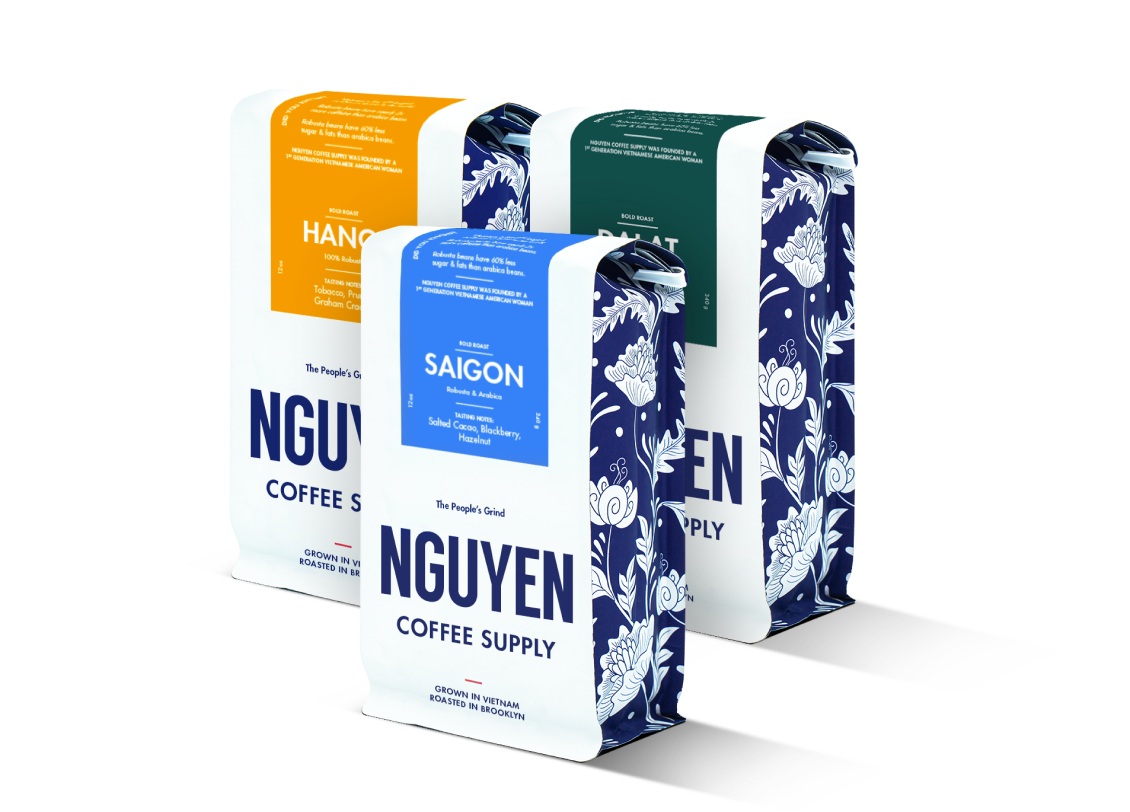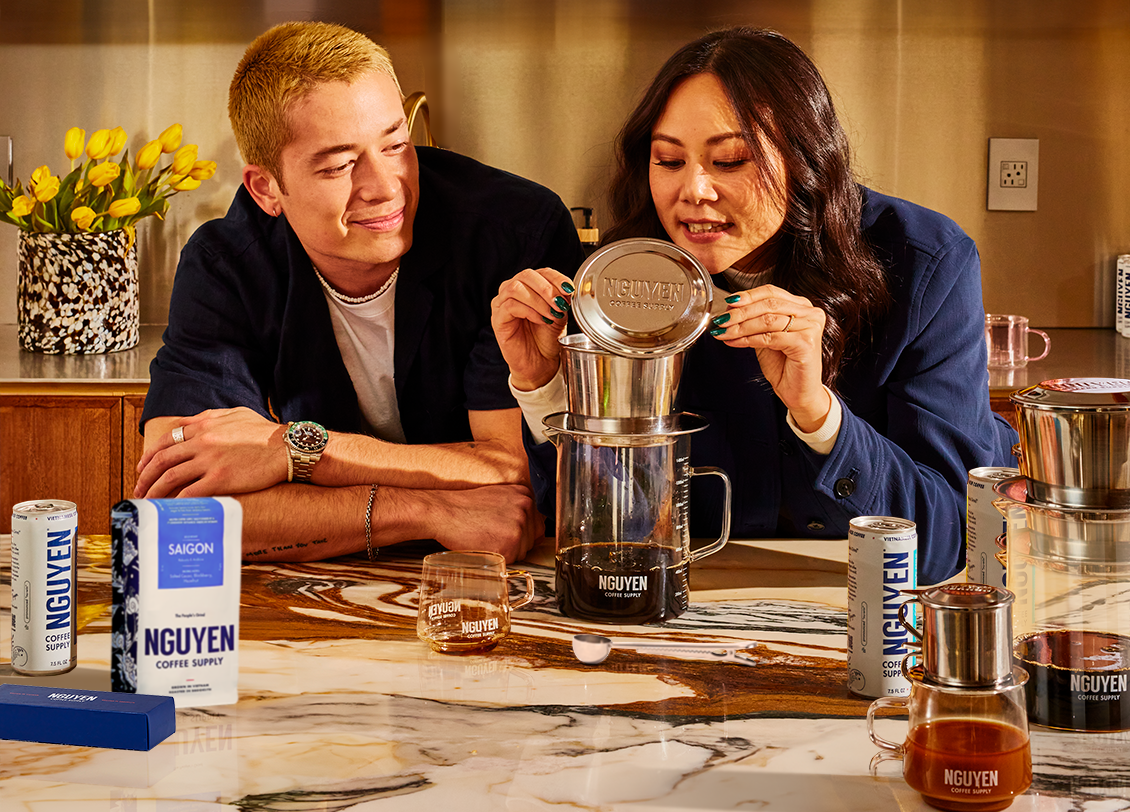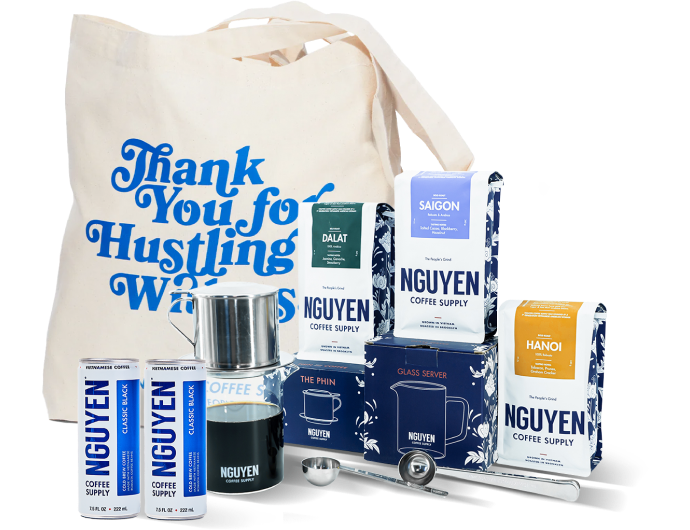

- FEATURED ON IMBIBE

Create for yourself or as a gift for your loved ones
Subscribe nowMe and mom just enjoyed the Nguyen phin drip experience. Wow. Proud of your work. We without hesitation enjoy the Vietnamese coffee and recommend your products. Thank-you to the Nguyen staff and tradition. From Canada eh!
The phin filter is the traditional method of brewing coffee in Vietnam. It is made of stainless steel or aluminum, much like a moka pot, but is much thinner and lighter. It is also frequently referred to as a “Vietnamese coffee press” or "Vietnamese coffee maker."
It consists of four essential parts:
There is, however, more than one single type of phin filter. Let’s explore the differences between different types of phin filters:
Both types of filter work well to extract and brew coffee grounds. We personally love gravity press filters as they allow gas in freshly roasted coffee to escape more easily during the brew, making for a less hands-on experience while lowering the chances of over-extracting the coffee!
The phin filter has many advantages. One of its distinct advantages is that instead of using a paper filter, it uses a metal filter— which, incidentally, is built-in. Both the brewing chamber and the filter plate act as metal filters. In an industry that produces an inconceivably high quantity of waste, the phin filter stands out for not needing paper filters or even replaceable metal ones.
The phin filter is also made using either aluminum or stainless steel— both highly recyclable materials. You may find some phin filters that include plastic handles. We make our phin filters with no plastic whatsoever — making the phin filter arguably among the best brewing methods for the environment!
We’ll go over other advantages of the phin filter later. First, let’s check out its history.
French colonization of Vietnam beginning in the 1880s saw the introduction of many French customs to Vietnam. One of these was the introduction of coffee as a crop— something that had been around for at least two decades before, but it was during this period that it became a serious source of income.
The French used a French press to make their coffee— but most Vietnamese people did not have access to them. As such, there are indications to show that the phin filter likely originated not in big cities– which were cosmopolitan in every way– but instead in rural areas where coffee was harvested. One indication is the tradition of using condensed milk for sweetening coffee, a widely spread practice in rural Vietnam.
Condensed milk was widely used by Vietnamese farmers as a means to preserve milk as it greatly extends its shelf life and doubles as dairy and as a sweetener. Nowadays, condensed milk is present in many types of Vietnamese drinks from the famous Vietnamese iced coffee to Vietnamese egg coffee. Out of need came ingenious brew tools and coffee additions that are now iconic.
Coffee most likely went from being a symbol of French rule to a source of national pride after the anti-French revolution— which started in 1946. Coincidentally, this would be when one of Vietnam’s most famous coffee drinks would be invented: the Vietnamese egg coffee.
Nowadays, the phin filter is the most widely used method for brewing coffee in Vietnam, where incredibly modern coffee shops are not a rare sight. And coffee, robusta in particular, is of great pride as a national product and an important pillar of the economy.
The basic principles of coffee extraction apply to the phin filter. It is most similar to a pour over like the Hario V60 or a French press: ground coffee is poured into the brewing chamber, where it is brewed using hot water. The main difference is that the press is traditionally introduced before pouring the brewing water, as opposed to after. It helps keep the coffee bed in place, which in turn results in a more concentrated brew.
The whole process takes about 6 minutes and it’s completely hands-off. You can simply pour the water and come back in five minutes and your coffee will be waiting for you. Gravity and hot water do their job well with this brew tool!
We recommend brewing your coffee in two steps instead of one. The first pour is for the coffee to bloom, a step that is very important when using fresh coffee as it releases the gases that become trapped inside the coffee beans during the roasting process (the more bubbles you see, the fresher the beans). A gentle bloom is associated with a more balanced taste in coffee, which is why it’s often suggested. The second pour uses the rest of the water to produce the full amount of coffee in your phin filter!
The phin filter is a great tool for making all sorts of coffee— particularly Vietnamese iced coffee, which has been gaining a lot of popularity in recent years because of how delicious and easy to make it is.
But in reality, the phin filter is a brewing method just like any other. This means that you can have it any way you want: black, with milk, iced, etc.
Here’s a simple guide for making coffee using a phin filter:
Ingredients:
Steps:
One important thing to keep in mind when brewing coffee in a phin filter is that the grind size matters immensely if you want to achieve solid results.
The usual rule of thumb is, when using a grinder, to use a setting that is between medium and fine. Espresso or pour over grind are not quite there— instead, aim for a grind size similar to that of the moka pot; that’s about one to two settings finer than the medium setting in most home coffee grinders.
Brew time should always be between five to six minutes. At around two minutes we should be seeing the first drips of coffee— if this doesn’t happen, it means extraction is taking longer than it should and there’s probably a problem. If the coffee drips sooner, that’s not an issue so long as it doesn’t brew completely within the first two minutes or so.
The most common problem when using a Vietnamese phin filter is the grind size is either too fine or too coarse, which means the water is flowing too fast (under extraction) or taking too long to flow through (over extraction). You want to avoid this by aiming for the 5 minute mark. Another common problem is an uneven coffee bed; water flows off to one side, which can also mean a weaker coffee than usual because the coffee is not equally extracted. To avoid this, stick to the ratio provided above (1 tablespoon of coffee to every 2 ounces of water) and make sure to even the coffee bed every time.
Now, let’s discuss the advantages and perks of the phin filter. Every brewing method has its unique perks. Here’s some of our favorite advantages of the phin filter:
Ultimately, the Vietnamese phin filter is among our favorite brew tools to make coffee and we believe it should be a part of every coffee corner much like your other tools, spoons, and brewers.
––
Learn how to brew fun coffee drinks using Vietnamese coffee here.